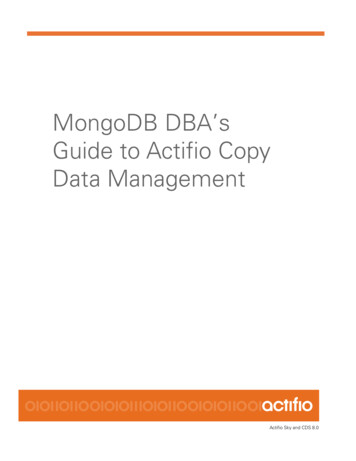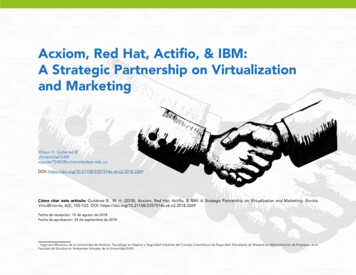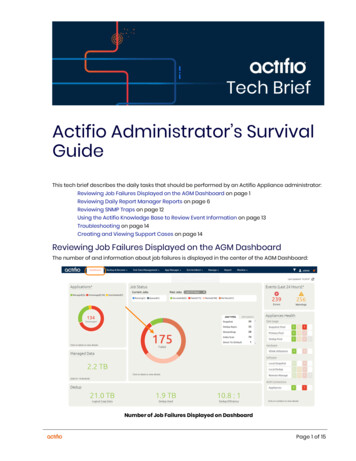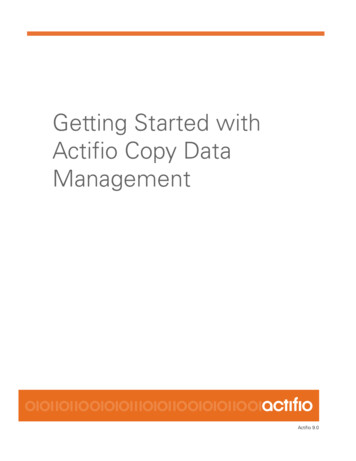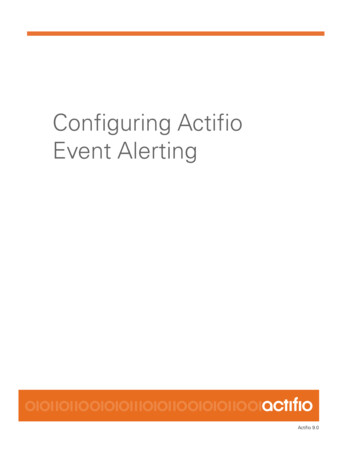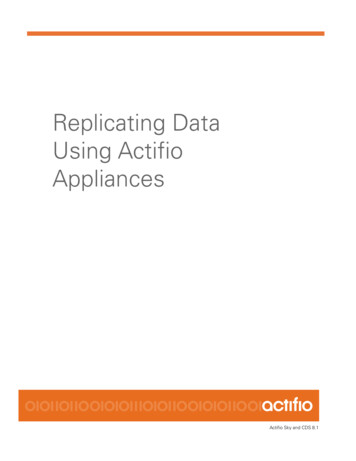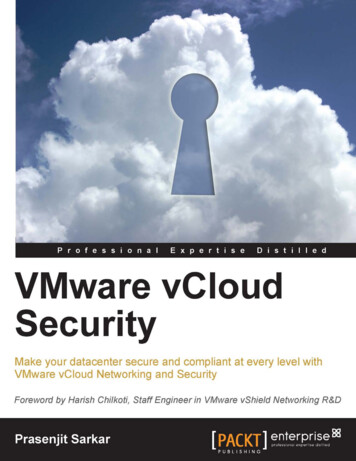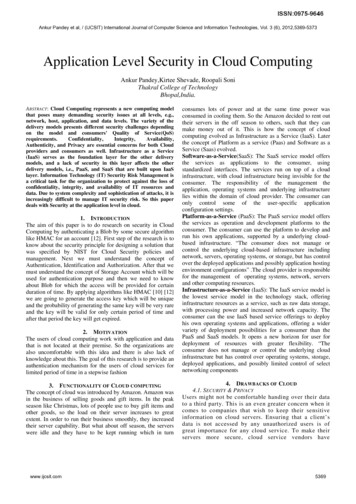
Transcription
Tech BriefData SecurityAll components of the Actifio Virtual Data Pipeline have been designed from the ground up with securityin mind and the IP interfaces as traditional attack vectors have been given particular focus in hardeningefforts.This chapter describes:Secure Operating System Access to Actifio Appliances on page 1Actifio VDP in a vSphere Environment on page 2Internet Protocol (IP) Network Security on page 2Access Control on Actifio Systems on page 3Authentication and Authorization on page 4Actifio Secure Connectivity and Data Movement with iSCSI in the Public Cloud on page 4Access Logging and Auditing on page 4Data Encryption on page 5Command Line (CLI) Access to Actifio VDP on page 6Vulnerabilities with Actifio VDP on page 6The Actifio Connector on page 7Secure Operating System Access to Actifio AppliancesActifio systems run on a hardened Linux software stack. Linux user accounts and direct access to theoperating system are not required nor employed for normal operations and support of the Actifiosystems. Direct access to the operating system can only be obtained via the use of time and systemlimited cryptographic credentials obtainable by select users within Actifio support and engineering whohave been undergone extensive background checks. Certificates are stamped with the identity of theuser to whom they are issued, the issuing is logged to an audit log, and all activities on a system whilelogged in using the certificate are logged along with the identity of the user. Actifio employs a lockeddown operating system that minimizes the possibility of unauthorized access. Even privileged users withdirect access to the appliance’s operating system can not access customer data unless they haveaccess to a host on the storage fabric which can mount and understand the data.Page 1 of 7
Actifio VDP in a vSphere EnvironmentWhen Actifio VDP is deployed on a public cloud, the instance itself is protected by the cloud's securityarchitecture. When deployed in an on-premises vSphere environment, the security of the instance isdependent on the configuration of the vSphere environment which hosts it. Insufficient security controlsof the vSphere environment could allow an attacker to perform a side-channel or side-loading attackand gain unauthorized access to data or privileges on the Actifio Appliance(s).While specific vSphere hardening is outside of the scope of this document, Actifio recommendscustomers follow VMware's best practices including, but not limited to, ensuring that the server BIOS andfirmware be kept up-to-date along with the ESXi and vCenter versions to mitigate the "Meltdown/Spectre"class of side-channel vulnerabilities. Additionally, virtual machine encryption (available in vSphere 6.5 ),can mitigate unauthorized tampering or side-loading of the Actifio Appliance(s) virtual disks. Customersshould consult with their internal IT and/or security teams, VMware, or other resources with regard tosecurity of a vSphere environment.Internet Protocol (IP) Network SecurityAll components of Actifio VDP have been designed from the ground up with security in mind and the IPinterfaces as traditional attack vectors have been given particular focus in hardening efforts.Standard Network ServicesThe following services are deployed and listening on open network ports: HTTP (80): Actifio Appliance resource center, provides local downloads of the Connectorsoftware. No appliance control or data access is possible on this portal. HTTPS (443): Provides TLS-encrypted communication between Actifio GUI clients and theappliance, as well as some appliance-to-appliance communication. SSL certificates may becustomer replaced. ssh (22): for user CLI ssh (26): for support CLI Actifio replication (5103): encrypted appliance-to-appliance data replication traffic. Both sidesof this link utilize strong mutual authentication of the partner appliance. iSCSI, iSNS (3260, 3205): iSCSI target cimserver (5989): SSL encrypted WBEM (CDS Appliance only and utilized for SRM integration) svrloc (427): service location for WBEM (CDS Appliance only)Appliance Outbound ConnectionsThe appliance may make outbound connections to the following services, but not does not listen on orrun a service for these ports unless listed above:2 LDAP/LDAPS (389/tcp, 636/tcp) Authentication of users against a central directory if configured DNS (53/udp) Resolution of addresses for hosts, VMs, vCenters, and other infrastructure NTP (udp/123) Clock synchronization against a customer-provided or public source SMTP (25/tcp, 465/tcp) Optional transmission of events via a customer-provided SMTP emailrelay server, can optionally utilize SSL encryption. SNMP (162/udp) Optional delivery of events in the form of SNMP traps to a trap receiver SSH (26/tcp) Encrypted intra-cluster communication between CDS Appliance nodes vSphere API (443/tcp) Required to communicate with vCenter servers and ESX hosts forsnapshot and image management during backup and mounts over an encrypted link. ESXi data connectivity (902/tcp) Encrypted connectivity to VMware ESXi hosts for datamovement operations.
Actifio Connectors (5106/tcp) Encrypted control channel between Actifio Appliance and hostsrunning the Actifio Connector. Appliance-to-appliance Replication (5103/tcp, 5107/tcp) Encrypted replication data and controlbetween two Actifio Appliances. SecureConnect (optional feature) remote support (1194/udp, 443/tcp) Encrypted remotesupport access to Actifio Connector data centers. As the connection is mutually authenticatedwith strong cryptography, it is recommended that the destination not be limited by a firewall.SNMPMost SNMP code on Actifio Appliances is outgoing only, sending traps to a configured receiver to notifyevents and failures.The exception is when integrated with Actifio Connector Optimized Storage or SAN Fabric, CDS Appliancesand CDX Appliances listen on UDP 162 for SNMP traps from specified IPs that are whitelisted for CDSAppliance Integrated Storage components.A list of whitelisted IP's can be viewed with the following commands. Currently SNMP v1 and v2 ageX.X.X.X5852DS3512--BstorageX.X.X.XNo Actifio configuration will ever accept any SNMP walk or write (e.g. GetRequest, SetRequest,GetNextRequest, GetBulkRequest) and this configuration of community names is not required orsupported.Cross Cluster Communication and ReplicationAll Actifio Appliances utilize strong mutual authentication of the partner appliance with verification of2048-bit RSA public keys.Once authenticated, data in flight between appliances is encrypted using 256-bit AES encryption withsession keys protected by Diffie-Hellman algorithms affording Perfect Forward Secrecy (PFS) over a TLSv1.2 channel.Access Control on Actifio SystemsActifio Connector uses a very rich role-based access control mechanism that allows an administrator toassign rights to users to operate on objects. These users and rights are constrained to operating onobjects owned by 'Organizations' of which they are members.A role consists of a group of rights. Roles are assigned to users to use those rights on specific objects.Users, Roles, Rights, and Organizations can all be modified and managed from either the CLI or the AGM.3
Coupled together, roles and organizations allow the customer to define a specific group of servers/hosts/applications that a given user can perform specific actions on.A Role Called Backup AdminAuthentication and AuthorizationActifio Appliance can either utilize an internal user directory or integrate with an external LDAP source,including Active Directory. This allows users to leverage their existing usernames and passwords,ensuring compliance with corporate password standards such as complexity and expiration. SSLencryption may optionally be utilized between the Actifio Appliance and the external LDAP server. LDAP/AD groups may be mapped to specific user-defined roles within the appliance.Access Logging and AuditingActifio maintains a full audit log of every command that has been executed on the platform, includinglogging requester’s IP address and method of access (CLI or AGM). The audit log can also be retrieved viathe Actifio REST API for automatic ingestion into a central log or event correlation repository. The audit log can be viewed from the CLI using the following command:sa--hq1: udsinfolsauditid username stat status component issuedate proxy command ipaddress privileged172675 admin 0 UI 13/12/2013 03:24:13.707 loginadmin 192.168.225.2 true172675 admin 0 CLI 13/12/2013 03:24:25.707 loginadmin 192.168.225.2 true172676 admin 0 UI 13/12/2013 03:24:14.124 lsprincipaldata1 192.168.225.2 false172677 admin 0 CLI 13/12/2013 03:24:26.578 lsdiskpooldatamdiskgrpLIKE'act ded% 192.168.225.2 false172678 admin 0 CLI 13/12/2013 03:24:28.469 lsdiskpooldatamdiskgrpLIKE'act pri% 192.168.225.2 false172679 admin 0 UI 13/12/2013 03:24:18.737 lsdiskpooldatamdiskgrpLIKE'act per% 192.168.225.2 false172680 admin 0 UI 13/12/2013 03:24:19.037 lsdiskpooldatamdiskgrpLIKE'act ded% 192.168.225.2 false172681 admin 0 UI 13/12/2013 03:24:24.579 appgroupingregular 192.168.225.2 false172682 admin 0 UI 13/12/2013 03:24:25.384 appgroupingremote 192.168.225.2 false172683 admin 0 UI 13/12/2013 03:24:25.900 appgroupingorphan 192.168.225.2 falseActifio Secure Connectivity and Data Movement with iSCSI in thePublic CloudWhen Actifio Connector is deployed in the public cloud, iSCSI is utilized to transfer data betweeninstances and the Actifio Appliance(s). Actifio establishes in-depth secure data transfer at multiple levelsto ensure that no Connector-equipped Host or Appliance can access unauthorized data.4
Actifio recommends that both the appliance(s) and instances communicate over the provider’s privatenetwork, using non-routable IP addresses. Under these conditions, the traffic will be protected by theprovider’s software-defined network and subject to all of the protections and external accreditations (e.g.SOC2 and ISO27001) most public cloud providers offer.Actifio also recommends: Firewall rules at the Public Cloud level that restrict iSCSI and/or control channel communication(5106/tcp) between the authorized appliance(s) to authorized instances only. Enable bi-directional iSCSI authentication (CHAP) utilizing pre-shared secrets that must beknown to both the appliance(s) and the authorized instances before any data can beaccessed. Install the appliance(s) certificate(s) in the Connector’s trusted certificate directory on eachinstance. Some providers automatically encrypt all data at-rest (e.g. Google Cloud). On public cloudswhere such encryption is optional (e.g. EBS encryption on Amazon Web Services), it should beenabled to protect the appliance(s) virtual disks.When properly configured, multiple levels of cryptographic authentication and security protect both thecontrol and data movement channels. Additionally, only instances that have been pre-registered withthe appliance(s) will be able to access data. All data operations are subject to the appliance(s) RoleBased Access Control (RBAC) that validate that a user is authorized to perform a certain operation, withcertain data, on a specific instance or host.Data EncryptionEncryption In FlightData inflight traveling between Actifio Appliances and to OnVault, as well as SecureConnect remotesupport sessions, is encrypted in flight using AES-256 with session keys exchanged via Diffie-Hellman.Management (GUI or CLI) sessions are protected utilizing the highest cipher negotiated between theclient computer and the Actifio Appliancee.Data traveling between Actifio and VMware environments is protected using the strongest ciphernegotiated between the Actifio Appliance and VMware ESXi/vCenter hosts up to and including AES-256.For hosts protected out-of-band using the Actifio Connector, the control channel between the applianceand the host is encrypted utilizing TLS and strongest cipher negotiated between the host and theappliance, however data movement occurs over iSCSI, which is not encrypted. If sensitive data is beingtransmitted via this mechanism it is recommended that this traffic be isolated to a given VLAN or subnet,or configured to use Fibre Channel, so that it cannot be intercepted. Traffic between an appliance and ahost over iSCSI is not encrypted in flight.Encryption At RestAdministrative end-user credentials are hashed with a strong one-way salted SHA256 hash in theappliance database. Credentials used by the appliance to access other systems (vCenters, databases,etc) are stored in an AES256 encrypted form.Sky Appliances encrypt customer data (snapshots and dedup) utilizing AES 256-bit encryption. ActifioCDS Appliances and CDX Appliances rely on optional encryption at the hardware layer through the use ofSelf Encrypting Drives (SED)-containing storage arrays. Internal system drives on CDS Appliances,including optional SSD cache, do not store customer data.Note: Actifio CDX Appliances have a heartbeat connection between the two nodes. This connection isnot encrypted.5
Command Line (CLI) Access to Actifio VDPFollowing the security principle of separation of duties, Actifio uses two command line (CLI) interfaces forcustomer end-users and Actifio support personnel. These are described in detail below.User CLI AccessOne CLI interface is for general user access and is only accessible by users defined in the ActifioAppliance. This is accessible via an SSH based login via port 22 on either the primary cluster IP address ornode IP addresses. All CLI access is via key based authentication only. This avoids the threat of brute forcepassword attacks and social engineering of password theft.A user must generate an SSH public key, and that public key must be installed on the user’s account by anadministrator before CLI access is granted.The User CLI login allows authenticated users access to a heavily restricted shell where only Actifiospecific commands are available to be run. The full list of commands is documented in the ActifioDocumentation Library available from the Actifio Resource Center on each Actifio Appliance (http:// cluster-IP ). Users (including admin) have no ability to upload and execute arbitrary binaries, nor canusers escape the restricted shell to escalate their privileges.Support CLI AccessThe second CLI interface is for use by Actifio Support only. The time and system-limited login certificatesrequired to use this service can only be acquired via a secure portal. The username of the user whogenerated the SSH certificate is embedded within the certificate and all actions are audited with thisinformation allowing all activity to be positively tied to a specific individual.Any employee granted authorization to generate these access certificates is subject to rigorous scrutinyincluding a background check for every individual.The nature of this access mechanism means it's both very secure and fully traceable making it easy toidentify which individuals have logged in using the support credentials and what actions they haveperformed.Console CLI AccessAccess to the Actifio CLI is also available the console on the Actifio Appliance. Use of this is restricted toActifio staff who can leverage the key based login approach described above with the key loaded on aUSB stick to gain a support login to the system.Vulnerabilities with Actifio VDPActifio Engineering routinely monitors multiple sources for vulnerability information and makes availableto all customers hotfixes to mitigate any discovered vulnerability in a component utilized by theappliance:6 Common Vulnerabilities and Exposures Security Focus - Vulnerabilities Search - http://www.securityfocus.com/bid National Vulnerabilities Database (NVD).
The Actifio ConnectorThe Actifio Connector is a highly optimized service that runs as root (or the system account on Windows)that accepts connections from Actifio Appliances (CDS/CDX/Sky) and performs operations on the host tosupport backup, mount, and restore activities.The Actifio Connector runs with elevated privileges as it performs a significant amount of low-levelsystem functions including manipulating the SCSI bus, manipulating the LVM subsystem (whereapplicable), mounting/unmounting/formating volumes, loading and managing kernel modules (whenchange block tracking is enabled), copying any file on the host to the backup staging volume includingprotected OS files, accessing the MFT (on Windows NTFS), and more. As a C/C program, many of theseoperations are performed via native system calls and functions.Because Actifio recognizes the risk of running any process as root, a significant amount of securityarchitecture exists. The Connector utilizes statically linked libraries, it can validate with 2048-bit RSAcertificates the identity of any Appliance that connects to it and reject any untrusted connections, and ithas built-in "sudo"-like functionality to downgrade its privileges to other user accounts when it runs userspecified scripts or interacts with databases such as Oracle.Classified as a backup agent by most companies, the Connector has been deployed across tens ofthousands of customer systems in highly secure and regulated environments such as global financialinstitutions and banks, airlines, health care, and government agencies.7
All Actifio Appliances utilize strong mutual authentication of the partner appliance with verification of 2048-bit RSA public keys. Once authenticated, data in flight between appliances is encrypted using 256-bit AES encryption with session keys protected by Diffie-Hellman algorithms affording Perfect Forward Secrecy (PFS) over a TLS

